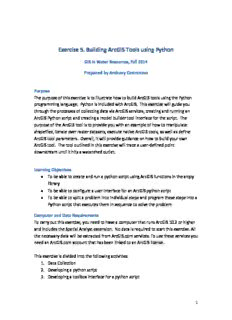
Exercise 5. Building ArcGIS Tools using Python PDF
Preview Exercise 5. Building ArcGIS Tools using Python
Exercise 5. Building ArcGIS Tools using Python GIS in Water Resources, Fall 2014 Prepared by Anthony Castronova Purpose The purpose of this exercise is to illustrate how to build ArcGIS tools using the Python programming language. Python is included with ArcGIS. This exercise will guide you through the processes of collecting data via ArcGIS services, creating and running an ArcGIS Python script and creating a model builder tool interface for the script. The purpose of the ArcGIS tool is to provide you with an example of how to manipulate shapefiles, iterate over raster datasets, execute native ArcGIS tools, as well as define ArcGIS tool parameters. Overall, it will provide guidance on how to build your own ArcGIS tool. The tool outlined in this exercise will trace a user-defined point downstream until it hits a watershed outlet. Learning Objectives To be able to create and run a python script using ArcGIS functions in the arcpy library To be able to configure a user interface for an ArcGIS python script To be able to split a problem into individual steps and program these steps into a Python script that executes them in sequence to solve the problem Computer and Data Requirements To carry out this exercise, you need to have a computer that runs ArcGIS 10.2 or higher and includes the Spatial Analyst extension. No data is required to start this exercise. All the necessary data will be extracted from ArcGIS.com services. To use these services you need an ArcGIS.com account that has been linked to an ArcGIS license. This exercise is divided into the following activities: 1. Data Collection 2. Developing a python script 3. Developing a toolbox interface for a python script 1 Part 1: Data Collection This section of the exercise uses ArcGIS.com tools to delineate a watershed and extract the DEM as you have done in previous exercises. This gets us the data for using in the model building and python scripting part that follows Open ArcMap. Connect to the ArcGIS hydrology server http://hydro.arcgis.com/arcgis. We will use this to delineate a watershed. If added correctly, you should see the following tools listed in ArcCatalog. Next, add a connection to the ArcGIS landscape1 server. We will use this web service to download and visualize National Hydrography Dataset (version 2) rivers. Use https://landscape1.arcgis.com/arcgis/services as the URL. If added correctly, you will see long list of datasets under the landscape1 service in ArcCatalog. 2 Finally, connect to the ArcGIS elevation web service. This will be used to downloading elevation data for the exercise. Use http://elevation.arcgis.com/arcgis/services as the URL. If added correctly, you will see a short list of tools and data available under the elevation service in ArcCatalog. Add some template data so that we can zoom into the location that we would like to download data. Select the Add Data button: 3 Navigate to the ArcGIS template data directory (C:\Program Files (x86)\ArcGIS\Desktop10.2\TemplateData\TemplateData.gdb\USA) and add US cities, interstates, and states. The map should now look like this: 4 Zoom into Logan, UT. Use the Identify tool to determine which of these dots is Logan. This will give us an idea of where we are, before we start loading ArcGIS web service datasets. Add the NHDPlus (version 2) data set from the landscape1.arcgis.com web service. We are only interested in the stream data, so turn off all NHD layers except Streams. This will help speed up the data load time. The layers in your table of contents should look like this: 5 Now that we have the NHD rivers loaded, we can zoom into Right Hand Fork. 6 To delineate a watershed at Right Hand Fork, we will use the ArcGIS online watershed delineation tool. Double click on the ArcGIS server watershed tool. Select an input point near the outlet of Right Hand Fork (see green dot on map). Don’t get too close to the Logan river (downstream), or the delineation tool will snap the outlet to the wrong reach. To ensure that this does not happen, you may have to adjust the snap distance (try 100 meters) This operation will result in the Right Hand Fork watershed. Go ahead and turn off all unnecessary layers and change the watershed color to something more meaningful. Export the in-memory watershed data to create a new shapefile, called watershed.shp. 7 We will use this new watershed.shp file in the following step to extract elevation data over the watershed. Add NED30m elevation from the elevation.arcgis.com server. 8 Next we want to extract the elevation data within the boundary of our watershed. This will make future data processing faster since we will be using a small subset of the national elevation dataset. In addition, this file will be stored locally so we won’t need an Internet connection to perform our processing tasks. To do this, open the search menu and enter “Extract”. Make sure to choose the search by “Tools” option above the search textbox. This will limit the search results ArcGIS tools. Since we are dealing with elevation data from an ArcGIS server, we want to select the “Extract Data (server)” tool. 9 Select the NED 30m elevation raster as the layer to clip. The Area of Interest that will be used to extract the data (i.e. cookie cutter) should be the watershed that you delineated in previous steps. Leave the default options for Feature Format, Raster Format, Spatial Reference, and Custom Spatial Reference Folder. Specify an output ZIP file where the extracted data will be saved. Open Windows Explorer and navigate to the directory of your output ZIP. Extract the contents, and you should now have an elevation dataset that covers only the watershed area. This is a good time to change the projection of our data frame to match the coordinate system of this elevation data. Also be sure to change the map units to be consistent with the units of the coordinate system. 10
Description: